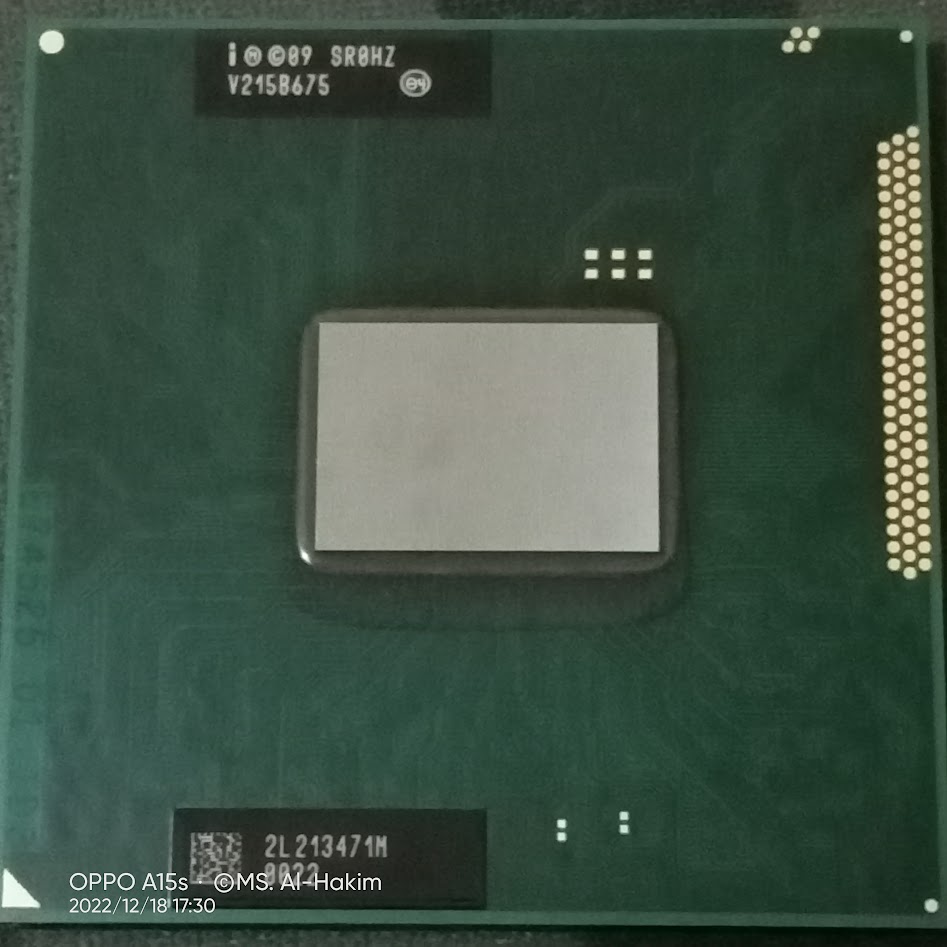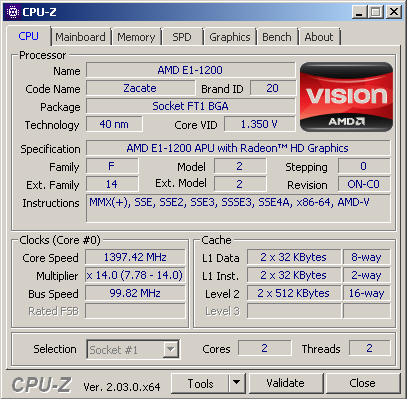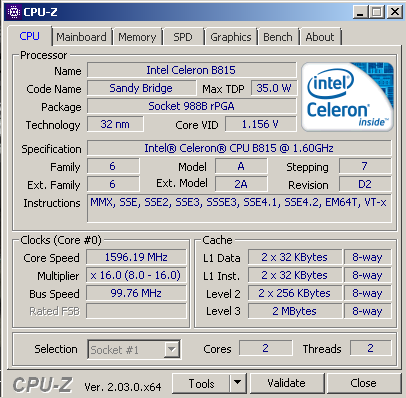Comparing: AMD E1-1200 vs Intel Celeron B815
In this comparison, we analyze two Processors: AMD E1-1200 and Intel Celeron B815, using synthetic benchmark tests to evaluate their overall performance. This side-by-side comparison helps users understand which hardware delivers better value, speed, and efficiency based on standardized testing. Whether you're building a new system or upgrading an existing one, this benchmark-driven evaluation offers valuable insights to guide your decision.
Specification Comparison Table
This specification comparison presents technical details of several devices or components to help you understand the key differences between each option. Use this table as a reference to determine which device best suits your needs.
| Specification | AMD E1-1200 | Intel Celeron B815 |
|---|---|---|
| Architecture | x86 | x86 |
| Technology | 40 nm | 32 nm |
| Clock | 1.4 GHz - - | 1.6 GHz - - |
| Core/Thread | 2 / 2 | 2 / 2 |
| Segmen | Mobile | Mobile |
Submission Comparison Table
This submission comparison table displays the number and details of benchmark data submissions from various devices or components. This information helps you understand the performance based on the benchmarks that have been tested, as well as providing an overview of the consistency and popularity of the available benchmark results.
| No. | Benchmark Software | AMD E1-1200 | Intel Celeron B815 |
|---|---|---|---|
| 1 | Cinebench - R15 |
44 cb |
104 cb |
| 2 | Cinebench - R20 |
79 pts |
207 pts |
| 3 | PiFast |
1min, 49sec, 900ms |
47sec, 490ms |
| 4 | SuperPi - 1M |
55sec, 754ms |
24sec, 976ms |
| 5 | wPrime - 32M |
1min, 8sec, 78ms |
41sec, 44ms |
Submission Comparison Chart
This chart visualizes the benchmark scores comparison between two hardware devices based on submitted data.
Media Gallery
A collection of photos of tested hardware. These images can help you identify the physical form, model, and variant of the hardware in question. These photos are from our own documentation, and if they are not available we may not be able to document them.
About Hardware AMD E1-1200
Released in 2012 as part of the Brazos 2.0 family, the AMD E1-1200 is a power-efficient processor aimed at entry-level laptops. It has a 2 core and 2 thread configuration with a fixed clock speed of 1.4 GHz, with no support for Turbo Core technology. Built with a 40nm fabrication process, the E1-1200 has a TDP value of 18 watts-efficient enough for portable devices that emphasize low power consumption and longer battery life. Despite its limited performance, the E1-1200 was a popular choice in its day thanks to its affordable price and ability to handle light computing needs.
One of the main advantages of the AMD E1-1200 is the integrated Radeon HD 7310 GPU, which offers better graphics performance than Intel's entry-level graphics solutions at the time. This GPU has the ability to play HD resolution videos smoothly, as well as run light games such as Counter Strike 1.6, Plants vs Zombies, or other casual games with minimum graphics settings. That said, this combination of CPU and GPU is not intended for heavy-duty work such as video editing, 3D rendering, or modern gaming. Overall performance is more optimal when used for tasks such as browsing, streaming videos, accessing social media, typing documents, as well as basic office applications.
However, it should be noted that the AMD E1-1200 is less suitable for heavy multitasking, especially in modern operating systems like Windows 10. With a low clock speed and no Boost feature, users may experience lag or limitations when opening multiple applications at once. In tests using the HP 1000 1b05au laptop, this processor was paired with 4GB DDR3 single channel RAM (2 DIMM slots) and tested on Windows 7, Windows 8, and Windows 10 operating systems. The results show that the most optimal performance is achieved on Windows 7 or Windows 8, while in Windows 10 the system tends to be slow although it can still be used for basic needs. As such, the AMD E1-1200 can still be relied upon as a power-efficient and inexpensive solution for users with very light computing needs.
Hardware Detail:
Device: HP 1000 1b05au
RAM: 4GB DDR3 Single Channel 2 DIMM
OS: Windows 7, Windows 8, Windows 10
Wednesday, 26 December 2012 14:27:36 | Update: 1 month ago
About Hardware Intel Celeron B815
The Intel Celeron B815, released in 2012, is an entry-level mobile processor based on the Sandy Bridge architecture. Designed for budget laptops, it features 2 cores and 2 threads with a fixed clock speed of 1.6 GHz. The processor does not support Turbo Boost or Hyper-Threading, limiting its multitasking capabilities.
Manufactured using 32nm process technology, the Celeron B815 has a TDP of 35W, which is relatively high for a low-end mobile CPU. This higher thermal output typically results in shorter battery life and more heat generation compared to modern low-power processors.
For graphics, the processor is equipped with Intel HD Graphics 2000, which runs at a base frequency of 650 MHz and can boost up to 1.0 GHz. While not suitable for gaming, this integrated GPU handles basic visual tasks like 720p video playback, simple animations, and light graphical workloads adequately.
In everyday usage, the Celeron B815 performs best with lightweight applications such as web browsing, word processing, and playing standard-definition videos. However, it struggles with modern operating systems, multitasking, and heavier workloads due to its limited core/thread count and lack of advanced CPU features.
Hardware Detail:
Device: SAMSUNG 300E4Z
RAM: 4GB DDR3 Dual Channel
OS: Windows 7
Sunday, 27 November 2022 02:25:40 | Update: 1 month ago






